


 X
X
 R
R
R
IV.3.2 Palladium-Catalyzed Cascade Carbopalladation: Termination by Nucleophilic Reagents
STEFAN BRÄSE and ARMIN DE MEIJERE
A. INTRODUCTION
Domino or cascade reactions are particularly valuable for the construction of various carboand heterooligocyclic systems with three, four, or even more annelated rings. The Heck reaction has successfully been employed in various inter–inter-, intra–inter-, inter–intra-, as well as all-intramolecular reaction cascades. In this section, such processes with a termination by attack of various nucleophiles will be described.
A cascade Heck reaction with termination by nucleophiles is considered to start with an oxidative addition of a heteroatom–carbon bond (starter) onto a palladium(0) species (startup reaction), followed by carbopalladation of a nonaromatic carbon–carbon double or triple bond without subsequent dehydropalladation (relay), a second and possibly further carbopalladation of a carbon–carbon double or triple bond (second etc. relay). The terminating step is a displacement of the palladium residue by an appropriate nucleophile. It is crucial for a successful cascade carbopalladation that no premature dehydropalladation takes place, and that can be prevented by using alkynes and 1,1- disubstituted alkenes (or certain cycloalkenes) as relay stations since they give kinetically stable alkenylor neopentylpalladium intermediates, respectively. In addition, reaction of haloalkenes with alkenes in certain cases may form -allyl complexes, which are then trapped by various nucleophiles.
This section is organized in terms of decreasing molecularity types of termination reactions, and attainable ring sizes or ring combinations.
B. ALL-INTERMOLECULAR CASCADE CARBOPALLADATIONS
All-intermolecular cascade reactions involving nucleophilic attack at the end are at least three-component reactions. For a successful outcome the balance of reactivities of each component in the reaction mixture toward each other must be just right.
Handbook of Organopalladium Chemistry for Organic Synthesis, Edited by Ei-ichi Negishi ISBN 0-471-31506-0 © 2002 John Wiley & Sons, Inc.
1405

1406 |
IV Pd-CATALYZED REACTIONS INVOLVING CARBOPALLADATION |
B.i. Termination by Hydride
The prototypic substrate for intermolecular cascade reactions is norbornene or one of its analogs. Starting from an aryl halide, addition of the formed palladium species to the strained double bond of norbornene yields a norbornylpalladium derivative, which cannot undergo -hydride elimination but can accept hydride, for example, from piperidinium formate (Scheme 1)[1] or potassium formate,[2] the latter reaction occurring even at room temperature.
|
Pd(OAc)2, Bu4NCl |
H |
||
I |
|
piperidine, DMF, |
||
+ HCOOH |
60 °C, 8 h |
|
||
+ |
|
|
|
|
|
83% |
|
|
|
|
|
|||
Scheme 1
Other possible relays are mostly alkynes, which, after carbopalladation, undergo a surprisingly clean reductive demetallation with formic acid salts (Scheme 2).[3] At this point it is crucial that the catalyst cocktail has the appropriate composition, as yields under different conditions can vary substantially.[4],[5] The high degree of regioselectivity starting from propynoic acid amides has been attributed to coordination with the amide functionality.
Me |
I |
+

 + HCOOH
+ HCOOH
CONHMe
Pd(dba)2, HNEt2 |
Me |
|
EtOAc, reflux, 18 h |
||
MeHNOC |
||
|
||
90% |
||
|
H
Scheme 2
Similarly, , -unsaturated ketones and aldehydes react with aryl halides to give conjugate addition type products in the presence of formic acid and a base.[6 ]–[9]
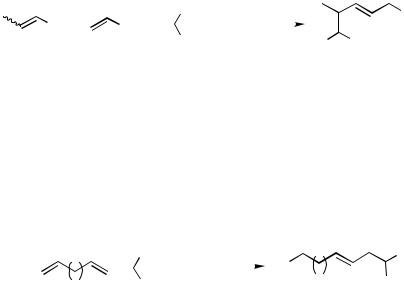
IV.3.2 CASCADE CARBOPALLADATION TERMINATED BY NUCLEOPHILES |
1407 |
B.ii. Termination by Carbon Nucleophiles
B.ii.a. Coupling with Soft Carbon Nucleophiles. The coupling of haloalkenes with alkenes and dialkyl malonates in the presence of a suitable base is an efficient three-component reaction leading to substituted allylmalonates.[10] Based on the constitution and configuration of the final products, it is assumed that the initially formed -homoallylpalladium intermediate rearranges—most probably by -dehydropalladation and rehydridopalladation with reversed regiochemistry—to a -allylpalladium complex, which is eventually attacked by the malonate enolate (Scheme 3). As far as the overall outcome is concerned, analogous intra–inter- as well as fully intramolecular cascade processes have been established (see below, Schemes 22 and 35).
|
|
|
Pd(OAc)2, P(o-Tol)3, |
|
||
|
|
E |
n-Bu4NCl, NaH, |
|
||
|
|
DMF, 100 °C, 42 h |
C4H9 |
|||
Br |
+ |
+ |
||||
65–73% |
|
|
||||
|
C4H9 |
|
||||
|
|
E |
|
E |
E |
|
E or Z |
|
E = CO2Me |
|
|
100% E |
|
|
|
|
|
|
||
Scheme 3
Aryl halides, nonconjugated dienes, and stabilized enolates can be coupled in high yields. Apparently, this process consists of an addition of an arylpalladium halide intermediate to the less hindered C,C double bond, palladium migration by a sequence of-hydride elimination, and readdition steps with eventual formation of a -allylpalladium complex and its coupling with a nucleophile (Scheme 4).[11]
|
|
Pd(dba)2, NaHCO3 |
|
|
|
EWG |
n-Bu4NCl, DMSO |
EWG |
|
|
80 °C, 8−48 h |
|||
ArI + |
+ |
|
Ar |
n |
|
||||
|
n |
52−81% |
EWG |
|
|
EWG |
|
|
|
|
|
|
|
|
n = 2, 4, 10 EWG = CO2Et, CN, COR
Scheme 4
B.ii.b. Termination by Boronates (Heck–Suzuki Cascade), Stannanes (Heck–Stille Cascade), or Cyanide Ion. The Heck reaction of aryl or alkenyl halides with norbornene can be terminated by coupling with either a boronate (Scheme 5, Eq. 1)[12] or an alkenylstannane (Scheme 5, Eq. 2)[13] to stereoselectively formed vicinal biscoupling products with formation of two new C,C bonds.
Toward the synthesis of leukotriene model compounds, combinations of appropriately substituted alkenyl halides and alkenylstannanes have been used in this three-component reaction applied to norbornadiene (Scheme 6).[14]
Besides norbornene and norbornadiene, 1,3-dioxolenes are possible partners in these ternary couplings. Hence, starting from unsubstituted or 2-substituted 1,3-dioxolene, tributylphenyltin, and various bromoarenes, cis-4,5-disubstituted 1,3-dioxolanes are obtained in good yields (Scheme 7).[15]
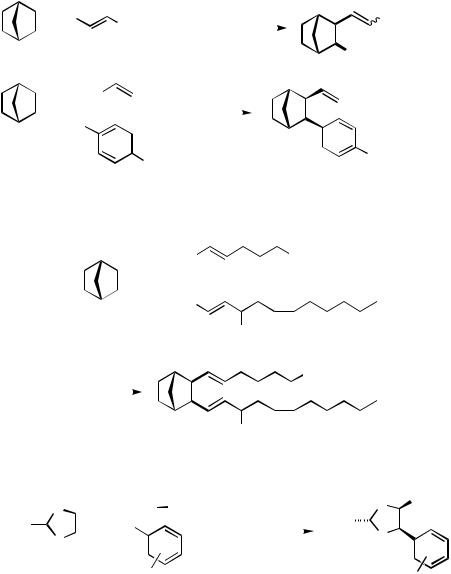
1408 IV |
Pd-CATALYZED REACTIONS INVOLVING CARBOPALLADATION |
|
|
|
|||||||||||||||||||||||||
|
|
|
|
|
|
|
|
|
|
|
|
|
|
|
|
Pd(PPh3)4 |
|
|
|
|
|
|
|
|
|||||
|
+ |
Br |
Ph |
+ |
|
NaBPh4 |
|
PhOMe, 80 °C |
|
|
|
|
Ph |
|
|
||||||||||||||
|
|
|
|
|
|
|
|
||||||||||||||||||||||
|
|
|
|
|
|
|
|
|
|
|
|
|
|
|
|
|
|||||||||||||
|
|
|
|
|
|
|
|
|
|
|
92% |
|
|
|
|
|
|
|
|
|
(1) |
||||||||
|
|
|
|
|
|
|
|
|
|
|
|
|
|
|
|
|
|
|
|
|
|
|
|
||||||
|
|
|
|
|
|
|
|
|
|
|
|
|
|
|
|
|
|
|
|
|
|
|
|
|
Ph |
|
|
|
|
|
|
Bu3Sn |
|
|
|
|
|
|
|
Pd(PPh3)4, |
|
|
|
|
|
|
|
|
|||||||||||
|
|
|
|
|
|
|
|
C6H6 , 100 °C, 10 h |
|
|
|
|
|
|
|
|
|||||||||||||
|
|
|
|
|
|
|
|
|
|
|
|
|
|
|
|
||||||||||||||
|
+ |
|
|
|
|
|
|
|
|
|
|
|
|
|
|
|
|
|
|||||||||||
|
|
|
|
|
|
|
|
|
|
|
|
|
|
|
|
|
|
|
|
|
|
|
|
|
|
(2) |
|||
|
|
Br |
|
|
|
|
|
|
99% |
|
|
|
|
|
|
|
|
|
|
|
|
|
|||||||
|
|
|
|
|
|
|
|
|
|
OMe |
|
|
|
|
|
|
|
|
|
|
|
OMe |
|
|
|||||
|
|
|
|
|
|
|
|
|
|
|
|
|
|
|
|
|
|
|
|
|
|
|
|||||||
|
|
|
|
|
|
|
|
|
|
|
|
|
|
|
|
|
|
|
|
|
|
|
|||||||
|
|
|
|
|
|
|
|
|
|
|
|
|
|
|
|
|
|
|
|
|
|
|
|||||||
|
|
|
|
|
|
|
|
|
|
|
|
|
|
|
|
|
|
|
|
|
|
|
|
|
|||||
|
|
|
|
|
|
|
|
|
|
|
|
|
Scheme 5 |
|
|
|
|
|
|
|
|
||||||||
|
|
|
|
|
|
|
|
|
|
|
|
|
|
|
|
|
O |
|
|
|
|
|
|
|
|
||||
|
|
|
|
|
|
|
|
|
|
|
|
|
Cl |
|
|
|
|
|
|
CO2Me |
|
|
|
|
|
||||
|
|
|
|
|
|
|
|
|
|
|
|
|
|
|
|
|
|
|
|
|
|
|
|
||||||
|
|
|
|
|
|
+ |
|
|
|
|
+ |
|
|
|
|
|
|
|
|
|
|
|
|||||||
|
|
|
|
|
|
|
|
|
|
|
|
|
|
|
|
|
|
|
|
|
|||||||||
|
|
|
|
|
|
|
|
|
|
|
|
|
Bu3Sn |
|
|
|
|
|
|
|
|
|
|
|
|
|
|
|
|
|
|
|
|
|
|
|
|
|
|
|
|
|
OH |
|
|
|
|
|
|
|
|
||||||||
|
|
|
|
|
|
|
|
|
|
|
|
|
|
|
|
|
|
|
|
|
|
|
|
||||||
|
|
|
|
|
|
|
|
|
|
|
|
|
|
|
|
O |
|
|
|
|
|
|
|
|
|||||
|
|
|
PdCl2(PPh3)2 |
|
|
|
|
|
|
|
|
|
|
|
|
CO2Me |
|
|
|
|
|||||||||
|
|
|
|
|
|
|
|
|
|
|
|
|
|
|
|
|
|
||||||||||||
|
|
|
THF |
|
|
|
|
|
|
|
|
|
|
|
|
|
|
|
|
|
|
|
|
||||||
|
|
|
|
|
|
|
|
|
|
|
|
|
|
|
|
|
|
|
|
|
|
|
|
|
|
|
|||
|
|
|
|
|
|
|
|
|
|
|
|
|
|
|
|
|
|
|
|
|
|
|
|
|
|
||||
|
|
|
|
|
|
|
|
|
|
|
|
|
|
|
|
|
|
|
|
|
|
|
|
|
|
|
|
|
|
|
|
89% |
|
|
|
|
|
|
|
|
|
|
|
|
|
|
|
|
|
|
|
|
|
|
|
|
|||
|
|
|
|
|
|
|
|
|
|
|
|
|
|
|
|
|
|
|
|
|
|
|
|
|
|
||||
|
|
|
|
|
|
|
|
|
|
|
|
|
|
|
|
OH |
|
|
|
|
|
|
|
|
|||||
|
|
|
|
|
|
|
|
|
|
|
|
|
Scheme 6 |
|
|
|
|
|
|
|
|
||||||||
|
O |
Bu3Sn |
|
Ph |
|
PdCl2(Po-Tol3)2 |
|
|
|
|
O |
Ph |
|||||||||||||||||
|
|
|
|
|
|
|
|
|
|
||||||||||||||||||||
R1 |
|
+ |
Br |
|
|
|
|
|
|
THF, 80 °C, 24 h |
|
|
|
R |
1 |
|
|
|
|||||||||||
|
|
|
|
|
|
|
|
|
|
|
|
|
|||||||||||||||||
|
|
O |
|
|
|
|
|
|
|
|
|
|
41–74% |
|
|
|
|
O |
|
|
|
||||||||
|
|
|
|
|
|
|
|
|
|
|
|
|
|
|
|
|
|
|
|
||||||||||
|
|
|
|
|
|
|
|
|
|
|
|
|
|
|
|
|
|
|
|
|
|
|
|
||||||
|
|
|
|
|
|
|
|
|
|
R2 |
|
|
|
|
|
|
|
|
|
|
|
|
R |
2 |
|
||||
|
|
|
|
|
|
|
|
|
|
|
|
|
|
|
|
|
|
|
|
|
|
|
|
|
|
|
|
|
|
|
|
|
|
|
|
|
|
R1 |
|
R2 |
Yield (%) |
R1 |
|
R2 |
Yield (%) |
||||||||||||||
|
|
|
|
|
|
|
|
H |
|
|
|
H |
74 |
|
|
|
|
H |
m-COMe |
62 |
|
||||||||
|
|
|
|
|
|
|
|
H |
|
|
|
p-NO2 |
57 |
|
|
|
|
H |
m-Me |
60 |
|
||||||||
|
|
|
|
|
|
|
|
H |
|
|
|
p-COMe |
73 |
|
|
|
|
H |
m-OH |
55 |
|
||||||||
|
|
|
|
|
|
|
|
H |
|
|
|
p-CHO |
70 |
|
|
|
|
H |
o-NO2 |
41 |
|
||||||||
|
|
|
|
|
|
|
|
H |
|
|
|
p-Cl |
67 |
|
|
|
|
H |
o-Me |
56 |
|
||||||||
|
|
|
|
|
|
|
|
H |
|
|
|
p-Me |
65 |
|
|
|
|
H |
o-OMe |
64 |
|
||||||||
|
|
|
|
|
|
|
|
H |
|
|
|
p-OMe |
57 |
|
|
|
|
Me |
H |
|
51 |
|
|||||||
|
|
|
|
|
|
|
|
H |
|
|
|
p-OH |
59 |
|
|
|
|
t-Bu |
H |
|
61 |
|
|||||||
Scheme 7
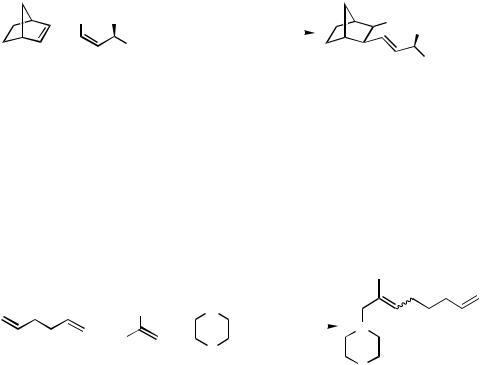
IV.3.2 CASCADE CARBOPALLADATION TERMINATED BY NUCLEOPHILES |
1409 |
Alternatively, cyanide can act as a terminating nucleophile to form nitriles when starting from norbornene and an alkenyl halide (Scheme 8).[16] Addition of the palladium intermediate of an enantiomerically pure haloalkene derivative to the double bond of norbornene produced only one of the two possible diastereomers, which was trapped by cyanide ion. Furthermore, the double bond in the product had (E )-configuration. Thus, the stereogenic center in the reactant fully controls the first newly formed stereogenic center in the product and, after the intermolecular carbopalladation step, an intramolecular 3-exo-trig carbopalladation followed by a cyclopropylcarbinylto homoallylpalladium rearrangement gives rise to the (E )-configurated double bond of the product.
|
|
|
Pd(OAc)2, PPh3 |
|
|
|
I |
OSiMe2t-Bu |
DMF, 80 °C, 12 h |
CN |
|
||
+ |
+ |
KCN |
|
|
|
OSiMe2t-Bu |
|
|
|||||
|
C5H11 |
95% |
|
|
|
|
|
|
|
|
|
C5H11 |
|
|
|
|
|
|
|
|
|
|
Scheme 8 |
|
|
||
B.iii. Termination by Amines
Early on, Heck and co-workers found that intraand intermolecular coupling reactions of haloalkenes with alkenes in the presence of secondary amines gave allylamines.[17],[18] Apparently, an intermediate -allylpalladium complex is formed by rearrangement of the-homoallylpalladium intermediate (see above, B.ii) and in turn attacked by the nitrogen nucleophile. Excellent yields of tertiary allylamines are obtained in this three-component coupling (Scheme 9).[19] As far as the outcome is concerned, analogous inter–intra- as well as fully intramolecular processes have been established (Scheme 30; see Table 1).[20]
Me |
H |
Pd(dba)2, Bu4NCl |
||
N |
DMA, 100 °C, 2 d |
|||
+ |
+ |
|
N |
|
98% |
||||
Br |
|
|||
|
|
|||
O
O |
E / Z = 83:17 |
Scheme 9
At this point, it is interesting to note that nonconjugated dienes react first with one double bond and the -allyl complex is formed by migration of the other double bond (Scheme 10).[21] This three-component reaction can be carried out with a full range of linear and branched dienes. An appropriate composition of the palladium catalyst cocktail is crucial for good yields, since under certain conditions, which were used earlier for this transformation,[22] substantial amounts of the diene or triene Heck coupling products were obtained.
Similar three-component reactions can also be carried out with bicyclopropylidene as an alkene partner. After carbopalladation across its double bond, rapid ring opening of the resulting 1-(cyclopropyl)palladium to a 3-cyclopropylidene-3-phenylpropylpalladium species occurs; subsequent rearrangement to a -allylpalladium species and its trapping
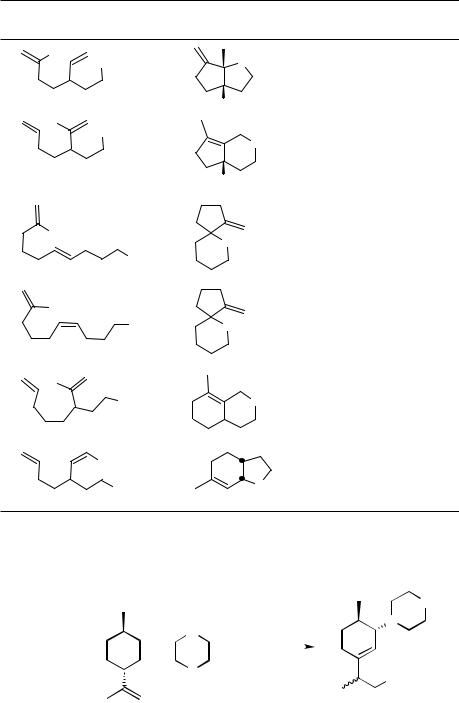
1410 |
IV Pd-CATALYZED REACTIONS INVOLVING CARBOPALLADATION |
TABLE 1. Synthesis of Azabicycloand Azaspiroalkane Derivatives: Cascade Cyclization of 2-Halo-1, n-alkadienes with Tethered N-Tosylamino Groups[79]
|
|
|
Temperature |
Time |
Yield |
Starting Materiala |
Product |
|
(°C) |
(h) |
(%) |
Br |
Ts |
|
|
|
|
NHTs |
N |
|
|
|
|
|
|
|
65 |
48 |
78 |
|
H |
|
|
|
|
Br |
|
|
|
|
|
NHTs |
|
NTs |
|
|
|
|
|
75 |
22 |
67 |
|
|
|
|
|||
|
H |
|
|
|
|
Br |
|
|
75 |
n.r.b |
ca. 50 |
NTs |
|
|
|
|
|
|
|
|
|
|
|
NHTs |
|
|
|
|
|
I |
|
|
75 |
n.r. |
ca. 50 |
|
|
|
|
|
|
NHTs |
NTs |
|
|
|
|
Br |
|
|
75 |
24 |
84 |
NHTs |
|
NTs |
|||
|
|
|
|
||
Br |
|
|
60 |
48 |
58 |
NHTs |
|
N |
|
|
|
|
Ts |
|
|
|
|
|
|
|
|
|
aPd(OAc)2, P(o-Tol)3, Na2CO3, Bu4NCl, DMF.
bn.r. = not reported.
O
|
|
H |
|
Pd(dba)2, Bu4NCl |
N |
|
|
|
N |
DMA, 100 °C, 2 d |
|
||
PhI + |
|
+ |
|
|
|
|
|
62% |
|
|
|||
|
|
O |
|
Ph |
||
|
|
|
|
|
||
|
|
|
|
|
|
|
47:15
Scheme 10

IV.3.2 CASCADE CARBOPALLADATION TERMINATED BY NUCLEOPHILES |
1411 |
with a primary or secondary amine then yields (73–99%) an allylamine with a methylenecyclopropane end group (Scheme 11).[23]
This transformation is related to the three-component reaction leading to 1-arylallyli- denecyclopropane derivatives (see Sect. IV.2.4).[24],[25]
|
|
|
|
H |
Pd(OAc)2, PPh3 |
|
|
|
|
||||
|
|
|
|
N |
DMF, 80 C |
|
|
|
|
||||
|
|
|
|
|
|
||||||||
PhI + |
|
+ R1 |
R2 |
|
|
|
|
Ph |
|||||
|
|
|
|||||||||||
|
|
|
|
|
|
|
|
|
R1 N R2 |
||||
|
|
|
|
R1 |
R2 |
Yield (%) |
|||||||
|
|
|
|
CH2CO2Me |
H |
96 |
|
|
|
|
|
|
|
|
|
|
|
n-Bu |
H |
73 |
|
|
|
|
|
|
|
|
|
|
|
i-Bu |
H |
73 |
|
|
|
|
|
|
|
|
|
|
|
t-Bu |
H |
95 |
|
|
|
|
|
|
|
|
|
|
|
Bn |
H |
98 |
|
|
|
|
|
|
|
|
|
|
|
Et |
Et |
75 |
|
|
|
|
|
|
|
|
|
|
|
–(CH2)5– |
|
79 |
|
|
|
|
|
|
|
|
|
|
|
–(CH2) 2O(CH2) 2– |
99 |
|
|
|
|
|
|
||
Scheme 11
C. INTER–INTRAMOLECULAR CASCADE CARBOPALLADATIONS
An inter–intramolecular cascade carbopalladation involves a two-component coupling with subsequent trapping by a nucleophilic moiety already present in one of the two starting materials. Based on the findings of Heck and co-workers, Larock developed a methodology for the synthesis of a wide range of benzoannelated heterocycles starting from o-iodoamino and o-iodohydroxyarenes by reaction with various alkynes (to give indoles),[26] certain alkenes such as norbornene,[27] ethenylcyclopropanes and -cyclobu- tanes,[28] allenes[29],[30] (see also Sect. V.2.1.10), and 1,3-dienes[31] as well as 1,4-dienes (Schemes 12 and 13).[32] Allylic alcohols[33] and enol triflates were also coupled with or without incorporation of carbon monoxide; however, these cascades do not include a termination by nucleophilic attack (for this chemistry see also Sects. V.3.2 and V.3.3).
This type of reaction can also be conducted with o-iodobenzylamines and -alco- hols[30],[31],[34] as well as with o-iodobenzoic acid derivatives to give lactones.[30],[34] o-Halobenzaldehydes react also with alkynes to give indenones[35]; however, this case might involve a C—H insertion of the preformed alkenylpalladium intermediate. Carbocyclic structures are attainable from o-iodophenylmalonates.[30] In some cases, moderate to good enantiocontrol is achievable using chiral ligands of the bisoxazolinyl type.[30]
C.i. Termination by Oxygen Nucleophiles
Since hydroxy groups do not interfere with palladium catalysts, the termination of carbopalladation cascades by oxygen nucleophiles has been employed in various cases. As
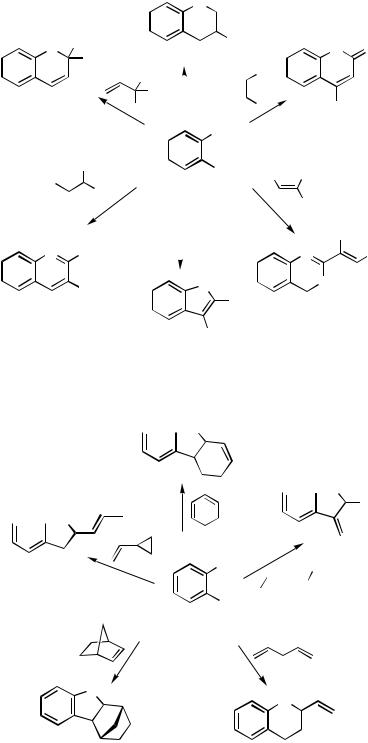
1412 IV Pd-CATALYZED REACTIONS INVOLVING CARBOPALLADATION |
|
|||||||||||||||||||
|
|
|
|
|
|
|
|
|
X |
|
|
|
|
|
|
|
||||
|
|
|
|
|
|
|
|
|
|
|
|
|
|
|
|
|
|
|
|
H |
|
|
|
|
|
|
|
|
|
|
|
|
|
|
|
|
|
|
|
|
|
|
O |
|
R1 |
|
|
|
|
|
|
|
|
R |
|
|
|
|
|
|
||
|
|
|
|
|
|
|
|
|
|
|
|
|
|
|||||||
|
|
R2 |
|
|
|
|
|
|
|
|
|
|
|
|
|
|
|
N O |
||
|
|
|
|
|
|
|
O |
|
E |
|
|
|
|
|||||||
|
|
|
|
|
|
|
|
|||||||||||||
|
|
|
R1 |
|
|
|
CO |
|
|
|
|
|
||||||||
|
|
|
|
|
|
|
|
|
|
|
||||||||||
|
|
|
R2 |
|
|
|
|
|
|
|
|
|
|
|||||||
|
|
|
|
|
|
R |
|
|
|
|
|
|
E |
|
|
|
E |
|||
|
|
|
|
|
|
|
|
|
|
|
|
|
|
|
||||||
|
|
|
OH |
|
|
|
|
|
|
|
|
|
|
|
||||||
|
|
|
|
|
|
|
|
|
|
|
|
|
|
|
||||||
|
|
|
|
|
|
|
|
|
|
|
|
|
|
|
|
|||||
|
|
|
|
|
|
|
|
|
|
|
|
|
|
|
|
|||||
|
|
|
X = O |
|
|
|
|
|
|
|
XH |
|
|
X = NH |
|
|||||
|
|
|
R2 |
|
|
|
|
|
|
|
I |
|
|
R1 R2 |
|
|||||
|
|
|
|
|
|
|
|
|
|
|
|
|
||||||||
|
|
|
|
|
|
|
|
|
|
|
|
|
||||||||
|
R1 |
|
|
|
|
|
|
|
|
|
|
|
|
|
||||||
|
|
OH |
X = NH, O |
|
|
|
|
|
|
|
||||||||||
|
|
|
|
|
|
LG |
|
|||||||||||||
|
|
|
|
|
|
|
|
H(R) |
|
|
|
|
||||||||
|
|
|
X = NH |
|
|
|
X = NH |
CO |
R2 |
|||||||||||
|
|
|
|
|
|
|
|
|
|
|
|
|||||||||
|
|
|
|
|
|
|
|
|
|
|
|
|
|
|
||||||
|
N R2 |
|
|
|
|
|
|
|
|
|
|
|
|
|
|
|
||||
|
|
|
|
|
|
|
|
|
|
|
|
|
N |
R1 |
||||||
|
|
|
|
|
|
|
|
|
|
|
|
|
||||||||
|
|
|
|
|
|
|
|
R |
|
|
|
|
|
O |
|
|||||
|
|
|
|
|
|
|
|
|
|
|
|
|||||||||
|
|
|
R1 |
|
|
|
|
|
X |
|
|
|
|
|
|
|||||
|
|
|
|
|
|
|
|
|
|
|
|
|||||||||
|
|
|
|
|
|
|
|
|
|
|
|
|
|
|
||||||
|
|
|
|
|
|
|
|
|
|
|
R |
|
|
|
|
|
|
|
||
|
|
|
|
|
|
|
|
|
|
|
|
|
|
|
|
|
O |
|
||
H(R)
LG = leaving group
Scheme 12

 X
X

 X
X
R

 X
X
 R
R
XH |
R |
 •
•
R
I
X = NH, O
X
X
Scheme 13

IV.3.2 CASCADE CARBOPALLADATION TERMINATED BY NUCLEOPHILES |
1413 |
discussed above, the Pd-catalyzed couplings of alkenyl halides with alkenes can give rise to the formation of -allylpalladium complexes, which can then be attacked by internal nucleophiles including hydroxy groups to yield various heterocyclic systems. For example, the coupling of o-allylphenol with -bromostyrene as well as various other alkenyl and cycloalkenyl halides and triflates in each case predominantly yielded the correspondingly 6-substituted 1,2-benzodihydropyrane derivatives (Scheme 14).[36]
|
Br |
|
Pd(OAc)2, n-Bu4NCl |
||||
|
|
|
DMF, 80 |
C, 24 h |
|||
|
|
|
|
|
|||
OH |
+ |
|
|
|
|
|
|
|
|
|
|
|
|
||
|
|
|
|
|
|||
|
|
|
|
|
|
|
|
|
+ |
|
|
|
Ph |
||
|
|
|
|
||||
|
|
|
|
|
|
|
|
O |
Ph |
|
O |
|
|
||
|
|
|
|
|
|||
82% |
|
|
8% |
|
|
|
|
R3 |
|
|
|
|
|
|
R3 |
X |
X = Br, I, OTf |
|
|
|
|
||
|
|
|
|
|
|||
R2 |
|
|
|
|
O |
|
R2 |
R1 |
|
|
|
|
|
||
|
|
|
|
|
R |
1 |
|
|
|
|
|
|
|
|
|
Scheme 14
, -Unsaturated or -aryl esters with a or an ortho leaving group (bromide, iodide, triflate) undergo coupling with internal alkynes to give substituted and ring-annelated 2- pyrone or isocoumarine derivatives, respectively, in good yields (Scheme 15).[37],[38] As in other cases of alkyne couplings, the regioselectivity is very high with alkynes bearing a tertiary alkyl, an aryl, a trialkylsilyl, or other reasonably bulky groups to yield single products having the more bulky group in the position adjacent to the heteroatom. From the mechanistic point of view, the reaction is believed to occur via an attack of the carbonyl oxygen on the alkenylpalladium intermediate formed by addition of an arylor alkenylpalladium moiety to the alkyne.[38]
The reactions of norbornene with o-iodo- and o-bromophenols proceed cleanly to give norbornane-annelated benzofurans (Scheme 16).[27] The reactions of 1,4-dienes yield benzopyrans in good yields (Schemes 12 and 13).[32]
O |
|
Ph |
|
O |
|||||||
|
|
|
|
|
Pd(OAc)2, Na2CO3 |
|
|
|
|
||
|
|
|
|
|
|
|
|
|
|||
OMe |
+ |
|
|
|
|
LiCl, DMF, 100 °C, 7 h |
|
|
|
O |
|
|
|
||||||||||
|
|
|
|
||||||||
|
|
|
|
|
|
|
|
|
|
||
Br |
|
|
77% |
|
|
|
|
Ph |
|||
|
CO2Me |
|
|
|
|||||||
|
|
|
|
|
|||||||
CO2Me
Scheme 15

1414 IV Pd-CATALYZED REACTIONS INVOLVING CARBOPALLADATION |
|
|||
|
OMe |
Pd(OAc)2, K2CO3 |
|
|
|
HO |
Bu4NCl, DMF |
O |
|
|
105 °C, 24 h |
OMe |
||
|
+ |
|
||
|
|
|
|
|
|
|
|
|
|
74%
I CHO
CHO
Scheme 16
C.ii. Termination by Nitrogen Nucleophiles
Because nitrogen-containing heterocycles are important building blocks for biologically active compounds including many natural products, efforts have been made to use an intermolecular C—C coupling with a subsequent internal heterocyclization. Thus, pyrrolidine derivatives are accessible by a cascade carbopalladation of a diene and intramolecular trapping of the intermediate -allylpalladium complex by secondary amines. In this case, an efficient enantiocontrol has been achieved using chiral phosphine ligands (Scheme 17, Eq. 1).[39] Similarly, the above mentioned three-component reaction with bicyclopropylidene (Scheme 11) has been performed with o-iodobenzyl alcohol to give a cyclopropylidene-substituted benzodihydropyran derivative (Scheme 17, Eq. 2). It is
|
|
Pd(OAc)2, |
|
|
|
|
n-BuN4Cl or Ag3PO4 |
|
|
NHBn |
|
phosphines, bases |
NBn |
|
|
|
DMF, 100 C, 1.5–10 d |
|
|
|
+ Ar-X |
|
(1) |
|
|
|
|
||
|
|
|
||
n–4 |
|
up to 95% yield, up to 80% ee |
n–4 |
Ar |
Ar = Ph, 2,6-Me-C6H3; X = I, OTf n = 5, 6
I |
|
|
|
|
|
|
I |
||
|
|
|
|
|
|
|
NH n-Bu |
||
|
|
|
|
|
|
|
|
||
|
NHi-Pr |
|
|||||||
|
|
|
|
||||||
(I) |
|
|
|
|
|
O |
|||
|
|
|
|
|
(I) |
||||
|
|
|
|
|
|
|
|
|
|
|
O |
29% |
|
31% |
|
|
|
||
(I): Pd(OAc)2, (o-Fur)3P, Et3N, DMF, 80 C, 24 h.[23] |
||||
|
|
|
Ph |
|
|
NHBn |
PhI |
|
|
|
(II) |
|
|
|
|
|
|
|
|
|
|
|
|
|
|
|
54% |
BnN |
|
|
|
|
||
|
|
|
E/Z = 9 |
: 1 |
(II): Pd(dba)2, dppe, Et3N, DMSO, 95 C, 42 h.[41]
Scheme 17
(2)
Nn-Bu
O
(3)
